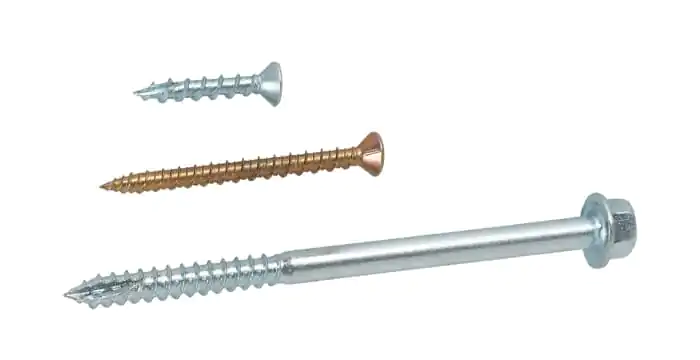When selecting materials for manufacturing fasteners, the choice of steel can significantly impact both the quality and performance of the product. But how do you know which steel type—low, medium, or high-carbon—is right for your needs? Let’s dive into their unique properties and uses.
Low-carbon steel has less than 0.30% carbon, making it easy to weld and shape, but less strong. Medium-carbon steel (0.30%-0.60% carbon) strikes a balance between strength and flexibility. High-carbon steel (over 0.60% carbon) is very strong and hard, ideal for tools, but it’s less flexible and more brittle.
Choosing the right type of carbon steel depends on the balance between strength, ductility, and weldability. Let’s break down the specifics of each grade to see how they differ and what makes each one suitable for its intended use. For more detailed comparisons, you can also check out our article on the key differences between carbon steel and stainless steel.

What Is Low-Carbon Steel?
Low-carbon steel, often referred to as mild steel, is a type of carbon steel that contains less than 0.30% carbon. This composition gives the steel its unique properties—making it highly ductile, malleable, and easy to weld. This steel is the most commonly used and is typically found in a variety of applications requiring formability and ease of production. Because of its low carbon content, the strength and hardness of low-carbon steel are relatively low compared to medium- and high-carbon steels. However, its easy fabrication and welding properties make it ideal for projects where these features are critical.
Low-carbon steel is a favorite in industries such as automotive manufacturing, construction, and consumer products. It’s affordable and readily available, and it’s versatile enough for use in fasteners, structural parts, and more. This is your go-to steel if you’re prioritizing easy processing over strength.
Properties of Low-Carbon Steel
Low-carbon steel exhibits several key properties:
- Ductility: High. This allows the material to undergo significant deformation without breaking.
- Malleability: Excellent. It can be easily shaped into various forms.
- Strength: Relatively low tensile strength compared to higher carbon steels.
- Weldability: Very good. Can be welded using standard techniques without any special requirements.
- Cost: Generally more affordable due to its ease of production.
Here’s a quick look at its mechanical properties:
| Property | Value |
|---|---|
| Density | 0.103 – 0.292 lb/in³ |
| Tensile Strength | 20,300 – 34,700 psi |
| Fracture Toughness | 30.0 – 105 ksi-in½ |
| Shear Modulus | 10,200 – 11,600 ksi |
| Melting Point | Approximately 2,600°F |
| Thermal Conductivity | 176 – 645 BTU-in/hr-ft²-°F |
Uses of Low-Carbon Steel in Fasteners
Low-carbon steel is widely used in fastener production for a variety of reasons. Its malleability, weldability, and cost-effectiveness make it an excellent choice for general-purpose fastening. Here are some typical uses:
- Bolts and Nuts: These are commonly used for general-purpose fastening in machinery, construction, and other industries.
- Screws: Perfect for applications requiring easy installation and removal.
- Washers: Used to distribute load and prevent damage to surfaces during assembly.
- Rivets: Utilized in applications where permanent fastening is required.
- Anchors: Widely used in masonry and concrete applications.
This steel is essential in almost every industry, offering reliable fastening solutions where strength demands are not as critical.
What Is Medium-Carbon Steel?
Medium-carbon steel, with carbon content ranging from 0.30% to 0.60%, is the perfect balance between low- and high-carbon steels. Its carbon content provides an ideal compromise between formability and strength, making it suitable for a wide range of applications. Often, manganese is added to enhance strength and hardenability, which improves its performance in specific applications, especially in machinery parts, automotive components, and tools. Medium-carbon steel is more challenging to weld than low-carbon steel but still offers good weldability if proper procedures are followed.
It can be heat-treated to increase its hardness, making it more adaptable for tougher, more demanding tasks. This type of steel is often chosen when a stronger material is needed without sacrificing too much flexibility.
Properties of Medium-Carbon Steel
Medium-carbon steel’s versatility lies in its balanced properties, which include:
- Strength: Moderate tensile strength, typically between 35,500 to 252,000 psi.
- Ductility: Good ductility, but less than low-carbon steel, meaning it can still deform but will break sooner under stress.
- Hardness: Moderate hardness, which can be increased through heat treatments like quenching and tempering.
- Weldability: Good, though welding should be done with care to avoid cracking.
- Fracture Toughness: Better than low-carbon steel, which means it resists cracking more effectively.
Key mechanical properties include:
| Property | Value |
|---|---|
| Density | 0.280 – 0.285 lb/in³ |
| Tensile Strength | 35,500 – 252,000 psi |
| Fracture Toughness | 73.7 – 130 ksi-in½ |
| Shear Modulus | 10,400 – 11,900 ksi |
| Melting Point | 2,597 – 2,800°F |
| Thermal Conductivity | 152 – 361 BTU-in/hr-ft²-°F |
Uses of Medium-Carbon Steel in Fasteners
Medium-carbon steel is ideal for more demanding applications that require additional strength. Its applications in fasteners include:
- Bolts and Screws: Used extensively in automotive and machinery applications where higher strength and durability are essential.
- Nuts: Used with bolts for secure fastening in heavy-duty applications.
- Washers: Helps distribute load and reduce wear on surfaces.
- Rivets and Anchors: Useful in construction and automotive industries, particularly in structural and load-bearing applications.
In the fastener industry, this steel is perfect when you need to balance cost, strength, and weldability.
What Is High-Carbon Steel?
High-carbon steel, which contains more than 0.60% carbon—typically ranging from 0.61% to 1.5%—is the strongest and hardest of the three types of carbon steel. The high carbon content results in a much harder material, making it perfect for high-wear applications that require durability, such as cutting tools and springs. However, the increased carbon also reduces ductility and malleability, making the steel more brittle and prone to cracking under stress. This means high-carbon steel is more challenging to work with compared to its lower-carbon counterparts, especially when welding.
Despite its brittleness, high-carbon steel maintains its edge longer and can withstand extreme pressure. If your fastener needs to withstand harsh conditions, this is your steel of choice.
Properties of High-Carbon Steel
High-carbon steel has several defining properties:
- Strength: Very high tensile strength, often ranging from 39,900 to 484,000 psi.
- Hardness: Extremely hard, which can be further enhanced through heat treatment.
- Ductility: Lower ductility, which makes it more prone to cracking and less flexible.
- Weldability: Challenging to weld due to its brittleness in the heat-affected zone.
- Fracture Toughness: Generally lower than that of lower-carbon steels, but still suitable for wear-resistant applications.
Here’s a quick look at its key properties:
| Property | Value |
|---|---|
| Density | 0.163 – 0.298 lb/in³ |
| Tensile Strength | 39,900 – 484,000 psi |
| Fracture Toughness | 12.0 – 150 ksi-in½ |
| Shear Modulus | 11,300 – 12,000 ksi |
| Melting Point | 2,800 – 2,900°F |
| Thermal Conductivity | 1,132 – 361 BTU-in/hr-ft²-°F |
Uses of High-Carbon Steel in Fasteners
High-carbon steel’s strength and hardness make it an ideal material for:
- Cutting Tools: Used in manufacturing knives, chisels, and saw blades due to its ability to maintain sharpness.
- Springs: Often used in applications requiring high strength and elasticity, such as in suspension systems.
- High-Strength Wires: Suitable for cables and ropes where tensile strength is paramount.
- Automotive Components: Used in parts like clamps, brackets, and other critical fasteners.
- Industrial Fasteners: Employed in applications with high stress and wear, such as heavy machinery.
High-carbon steel is essential in fasteners that need to endure extreme conditions.
Differences Between Low, Medium, and High-Carbon Steel
The key distinctions between low, medium, and high-carbon steel are rooted in their carbon content. The amount of carbon influences their strength, hardness, ductility, and other mechanical properties. Below is a detailed comparison of the three types of carbon steel, which will help you understand which is best suited for your specific fastener needs.
| Property | Low-Carbon Steel (0.05% to 0.32% carbon) | Medium-Carbon Steel (0.30% to 0.60% carbon) | High-Carbon Steel (0.60% to 1.5% carbon) |
|---|---|---|---|
| Strength | Low strength | Moderate strength | High strength |
| Hardness | Low hardness | Moderate hardness | High hardness |
| Ductility | High; very easy to form and weld | Moderate; less ductile than low-carbon steel | Low; more brittle and prone to breaking |
| Malleability | High; easily shaped | Moderate; harder to shape | Poor; difficult to shape |
| Weldability | Excellent; very easy to weld | Good; requires more care during welding | Challenging; prone to cracking during welding |
| Applications | General construction, automotive parts, and general fabrication | Machinery parts, automotive components, construction materials | Cutting tools, springs, high-wear applications |
| Fracture Toughness | Good (30.0 – 105 ksi-in½) | Better (73.7 – 130 ksi-in½) | Lower (12.0 – 150 ksi-in½) |
| Thermal Conductivity | Moderate (176 – 645 BTU-in/hr-ft²-°F) | Lower (152 – 361 BTU-in/hr-ft²-°F) | Higher (1132 – 361 BTU-in/hr-ft²-°F) |
Conclusion
The differences between low, medium, and high-carbon steel revolve around their carbon content, which directly impacts their properties such as strength, hardness, and ductility. Each steel type has its ideal application—whether you’re looking for easy fabrication, a balance of strength and flexibility, or extreme durability.
Choosing the right type of carbon steel for your fasteners will depend on the specific demands of your project. If you’re working with standard or custom fasteners, Hengrui offers a wide range of high-quality fasteners to meet your needs. Whether you require low, medium, or high-carbon steel, we can provide you with customizable, on-time delivery options at competitive prices.
Feel free to reach out to us today for more information on how we can assist with your fastener needs!










